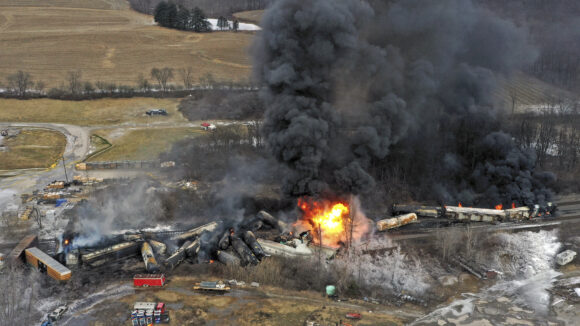The longer the freight train, the greater the risk of derailment, new research from the Society for Risk Analysis shows.
The study draws on the example of the February 2023, East Palestine, Ohio derailment, in which 38 cars from a 151-car, 9,300-foot-long freight train derailed, leading to the release of hazardous materials that forced the evacuation of more than 2,000 residents.
Longer and heavier freight trains have become more common, primarily driven by fuel efficiency, cost-savings, and emissions reduction measures in the railroad industry, the study shows.
The study, published in the journal Risk Analysis, was led by Peter Madsen of Brigham Young University’s Marriott School of Business. The quantitative analysis used information on U.S. freight train accidents over a 10-year period (2013-2022) from the Federal Railroad Administration (FRA) Rail Equipment Accident and Highway-Rail Grade Crossing Accident databases. There were roughly 35,000 reported incidents during this period in the two databases.
The study found that a 100-car train is more than twice as likely to experience a derailment than a 50-car train. The findings suggest that if the U.S. rail transport system employed 100-car trains rather than 50-car trains (requiring half as many trains overall), the systemwide risk of derailments would rise by 11%.
U.S. railroad operator Norfolk Southern said it had reached a $600 million deal to resolve a class action lawsuit related to the East Palestine, Ohio derailment last year. The agreement would resolve all class action claims within a 20-mile radius from the derailment and, for those residents who choose to participate, personal injury claims within a 10-mile radius.
In response to the Ohio derailment, U.S. Senator Sherrod Brown introduced the Railway Safety Act, which would require regulations of freight train length. The bill requires the Department of Transportation to issue safety regulations “for trains carrying hazardous materials to require that rail carriers or shippers (1) provide state emergency response commissioners with advanced notice and information about the hazardous materials; (2) reduce blocked rail crossings; and (3) comply with certain requirements regarding train length and weight specifications, track standards, speed restrictions, and response plans.”
The bill has been heard in several committees and continues to make its way through the Senate. Several U.S. states are currently considering state-level regulations regarding freight train length.
Related:
- Lawyers Want Ohio Residents to Wait for Details of $600M Derailment Settlement
- State Farm Sues Norfolk Southern Over Ohio Train Derailment Damages
- BNSF Becomes 2nd RR to Sign on to Anonymous Federal Safety Hotline for Workers
Top photo: This photo taken with a drone shows portions of a Norfolk and Southern freight train that derailed Friday night in East Palestine, Ohio are still on fire at mid-day Saturday, Feb. 4, 2023. (AP Photo/Gene J. Puskar).
Was this article valuable?
Here are more articles you may enjoy.


 Marijuana’s Move to Schedule III: What it Really Means for Cannabis Insurance
Marijuana’s Move to Schedule III: What it Really Means for Cannabis Insurance  Cat Bonds Linked to Wildfires Lose ‘Once Untouchable’ Status
Cat Bonds Linked to Wildfires Lose ‘Once Untouchable’ Status  NYT Asks Judge to Dismiss Trump’s ‘Implausible’ Defamation Suit
NYT Asks Judge to Dismiss Trump’s ‘Implausible’ Defamation Suit  Instacart to Pay $60 Million in FTC Consumer Protection Case
Instacart to Pay $60 Million in FTC Consumer Protection Case 